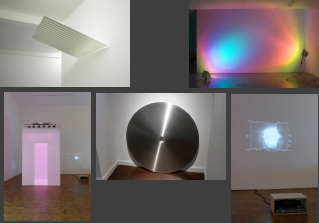I thought I should focus in this post on a contemporary artist which is currently exhibiting in Toronto: Ann Veronica Janssens. She is a Belgian artist who, from what I’ve seen so far, works mainly in light — that is, projected onto a wall — and machined cut-outs, such as large metal discs or grates. After looking at the description of the exhibition — which includes other artists — on the Power Plant website, I realized that it doesn’t really offer any formal insight; but instead offers the usual generic, thematic description, such as that “while many artists seek to engage the viewer in the awe and enigma of concepts of the universe, they are also concerned with shifts in the geo-political order brought on by the digital revolution, coupled with unresolved tensions that exist between differing belief systems.” While this certainly isn’t a bad start, it’s not much to chew on for someone who cannot visit the gallery itself.
Personally if I was to make a formal critique of her work, I suppose I should say first and foremost that her light installations are composed for the most part dichromatically, that is that they each light seems to use a dichromatic filter, displaying primary and secondary colours. When there is more than one light used, each section combines to create a virtual canvas, with one colour typically being more prominent than the others. This forming of a canvas on walls or materials, seems to be the common structure of her light works, and always serves a very minimalist aesthetic — as evidenced by single solid lines and semblances of technical displays, in addition to the dichromatic colour splashes. As for her far less numerous metal installations, they seem to me to be evidence of not only an extreme minimalism, but also a non-conventionality in their placement — that is, through the creation of unusual shadows — and thus a breakage with minimalists such as Hesse.
Here are a few examples of her work:
While this is certainly not all there is to say about the artist, I though this would be enough to wet the appetites of anyone who is particularily interested in light installations or minimalist works in general.
Click here for more examples of her work.



